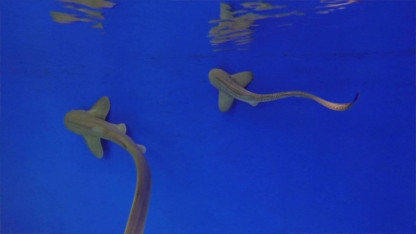Last week, a regular chicken egg became the most liked post on Instagram – but other “eggcellent” news was in focus here at National Aquarium Denmark, Den Blå Planet. A fertilised egg from a Stegostoma fasciatum commonly known as a zebra shark, has been found.
Zebra shark eggs are a tasty treat for most of the animal in the Ocean Tank, and usually get eaten before the divers can suit up and save the egg. In the video below you can see how an egg once got eaten by both an eagle ray and a zebra shark before the keepers could intervene.
The biggest of the eggs
After mating, a female zebra shark produces an egg capsule that measures up to 17 cm. Within the capsule there is a small shark foetus, that will double in size before being ready to make its escape. These eggs are the largest of the oviparous sharks, a subspecies of sharks that reproduce using eggs.
The whale sharks eggs are much larger than a zebra sharks, but they are a member of the ovoviviparous subspecies. This means that they fertilize, develop and hatch within the mother, and are then birthed as fully formed sharks.
It is common practice for some ovoviviparous sharks like sand tiger sharks and porbeagles, to eat their siblings while developing inside their mother, and that’s why they only give birth to a few sharks at a time…and you thought your family feud was bad!
See also: Den Blå Planet, National Aquarium Denmark just became one zebra shark richer
I’m seeing spots! Or is it stripes?
Nature likes to recycle its patterns, so it’s not uncommon to see tiger stripes or giraffe spots on aquatic animals.
What makes the zebra shark one of a kind, is that it is neither striped, nor black and white. In fact, many of our guests refer to it as a “leopard shark” when they see it, and although the logic is sound, seeing as they are a brownish/grey with black spots, they are in fact named after a zebra. Leopard sharks are an entirely different species of sharks who are also brown with black spots, but the spots are larger and more leopard like…confused yet?
There is however, method in the madness, as little baby zebra sharks are born with beautiful black and white stripes that disappear and change as they grow older. The stripes are so distinctive that they were named based on that, and luckily there is no bad blood between leopards and zebras. Well, at least under water.
Never count your chickens…
As the old saying goes, we are not promised a zebra shark until the egg hatches, so we remain cautiously optimistic. Luckily, hoping is free, so we have crossed all our fingers and the keepers at Den Blå Planet have done everything they can to provide an environment that will promote healthy growth and development.
If all goes well, the small stripy zebra shark babies will hatch in April and May, and will be moved to the shark nursery, right next to the hatchling aquarium.
Video in danish, where zookeeper Mia Rasmussen proudly present small “baby sharks”.
Zebra sharks can reproduce by themselves
In 2017 i Scientific Reports wrote an article about the female zebra sharks ability to change sexuality and reproduce without a male counterpart.
An Australian female zebra shark called Leonie lived with her mate in an aquarium from 1999 to 2012, where the two of them reproduced successfully several times. Since 2012, Leonie the shark has been living alone.
In 2016, Leonie surprised her keepers by having three babies without having come in contact with a male shark. It turns out that zebra sharks have the ability to reproduce asexually. This phenomenon is called parthenogenesis, and is seen in other animals, both within sharks and other species. It is however very uncommon for an animal to begin reproducing with a mate and switch over to reproducing independently.


